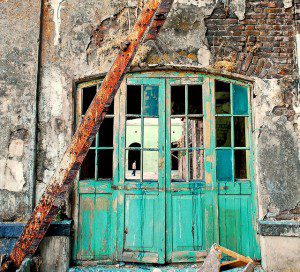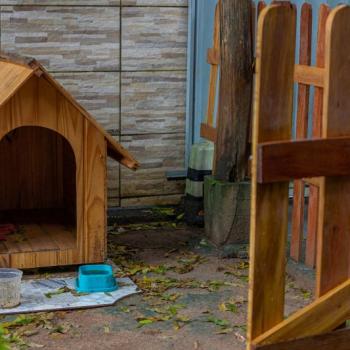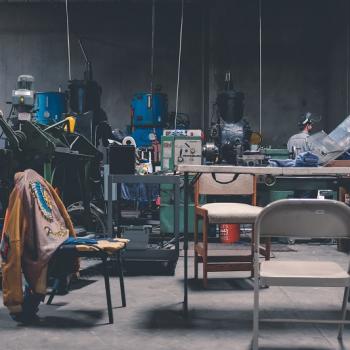 Recently, Comment magazine ran a two-part interview on their website with Jonathan Bradford, CEO of the Inner City Christian Federation in Grand Rapids, Michigan, in conjunction with their June issue on Christianity and the city.
Recently, Comment magazine ran a two-part interview on their website with Jonathan Bradford, CEO of the Inner City Christian Federation in Grand Rapids, Michigan, in conjunction with their June issue on Christianity and the city.
Many of us are interested in urban renewal and in alleviating poverty–but we don’t know where to start. Jonathan had plenty to say on the subject to his interviewer, James K.A. Smith of Comment. Here’s a sample.
First, he talked about the three specific areas ICCF involves themselves in as they try to help out in the housing market:
JS: In your own experience, and then in the specific kind of work ICCF does, there’s this interesting intersection of very concrete, tangible, hands-on, practical work helping people repair homes, build homes, care for homes, coupled with a little bit more big-picture, “abstract” policy work.
That comes out of your practical experience of learning how to fix homes but then also getting invested in, well, “seeking the welfare of the city.” Was your focus a strategic decision? The city has lots of problems. What made you focus on issues related to housing?
JB: Sure. Maybe this is as good as any time to tell you of our simple rule of threes here at ICCF. There are three key functions, three key program areas, and three key values…..The three functions work as if they were gears in a machine. They’re of equal size and equal importance. One gear not working? The other two won’t either. The first function is real estate development finance packaging—the very complex financial arrangements that are necessary to make a high-quality unit of housing available to somebody of lesser economic capacity. It takes a certain amount of magic. How do you pay $140,000 to build a housing unit when the target population can only afford $80,000? There’s got to be a way to close that $60,000 gap. That’s what we mean with that particular gear, our first function.
The second gear is residential construction. We are a licensed builder. Except in very large projects, we build everything ourselves so that we’re in full control of the budget, the quality of the work, and the timetable. We don’t want to set a family up for problems down the road. We don’t want mistakes and shortcuts to be hidden in the walls.
The third gear is housing education and empowerment. What we mean by that is this: sure, it’s good to be creative in the finance, and it’s good to be a responsible builder, but our target audience here, those that God is calling us to serve, are the Johnsons and Hernandez families. Most years, in the vicinity of about 2,500 households come to us facing all kinds of skill shortcomings. They likely never have lived in a home owned by a family member. They may not have ever experienced living in something that didn’t have a dozen or twenty code violations.
We want the family’s housing experience to be good for them so we encourage them attend to all kinds of skills-building opportunities, including housing repairs and maintenance (“Hey, how do you fix a broken window?” and that kind of thing—wall repair and painting and landscaping and all of those kinds of things)—but also the “soft” skills of housing and family management: insurance and taxes, time management, family budgeting, savings and investing, parenting. These are the kinds of things that quite a number of us either learned by example when we were young or had some other kind of mentoring relationship. Too often, that kind of experience is rare in the populations we serve.
From functions ICCF moves to progam areas, which include emergency shelter and rental properties as well as homebuilding:
Then there are three program areas. We have an emergency shelter for homeless families. Families stay with us for up to thirty days free of charge. We help them address the issues that cause their homelessness, help them find a permanent place to rent. That serves between seventy-five and eighty-five families a year.
Because home ownership is not suitable for everyone and the for-profit rental operator has a hard time meeting all the needs of the lower income renter ICCF had to enter the field of rental housing. We own and operate 142 units of high quality and affordable rental housing and soon we will be adding thirty more. Then finally is homeownership. For some families, it is good to own home. We do that either through the reconstruction of an existing house or new construction of a brand new house on a vacant lot.
 Finally, there are three key values important in serving this population–respect, opportunity, and beauty:
Finally, there are three key values important in serving this population–respect, opportunity, and beauty:
All of this is informed by our three key values, which are fundamental to all we do. We believe strongly in our responsibility to respect the Johnson and Hernandez families. God has thought enough of them to create them in His image. He wants good for them. He wants opportunity and hope and flourishing and nurture. He wants shalom. He wanted shalom for my wife and I when we were married forty-two years ago. We had various ways that helped us achieve that, a college degree, supportive parents, and so forth. The Johnsons and the Hernandez families may not have that.
Respecting these families that God sends our way means not holding wrongs against them, just as we read in 2 Corinthians 5: “The old is gone and new has come.” We have that reconciliation, and we read later on, “Therefore be as ambassadors don’t receive the grace of God in vain.” I believe very strongly that this call on contemporary Christians is all-inclusive. It often has been applied only to a spiritual dimension of our relationship to God: “Is my heart right with the Lord?” But I believe strongly that God’s care extends far beyond my heart and to every area of my activity, all of my being as a citizen in His Kingdom and in the city. Respecting the family, not holding the wrong turns against them, communicating hope and optimism is an extremely important thing.
Second value: opportunity. How do we respect? By expecting the pursuit of opportunity. That might sound like just a little clever turn of a phrase but, hey, you know what? If you regard the Hernandez and Johnson families as perfectly capable—as wanting good for themselves, as reaching for something more—for stability that has eluded them. We want to say to them: here is your chance to learn, to grow. “Mr. Johnson, Mrs. Johnson, what have you aspired to achieve?” Inevitably, we’re going to hear a financial roadblock. They’re going to say, “Yeah. I wanted to take that course at community college so I could qualify for a raise at work but I could never get the $300 tuition together.” “Well, sure, Mr. Johnson because you’re spending 55% of your income on inadequate, unsafe housing and there’s no reason why you should have to continue to do that.”
When Mr. Johnson can go from spending $850 to spending $550, Mr. Johnson has a $300 a month raise. That’s $3,600 post-tax cash stays in his pocket. What, Mr. Johnson, can you do with $3,600? Will you take that class at the community college? Will you address the health issue you’ve been denying, ducking? On and on, the pursuit of opportunity.
The final word, the final value that is, to my way of thinking as powerful, as important, as central as anything: that is simply beauty.
Here at ICCF, Jamie, we talk about beauty as a gift of God. Created in His image, we have that unique, that very special capacity to seek and to embrace that which is aesthetically satisfying. The Lord is the author of all that is right and proper and in the shaping, in the colouring, in the dimensioning of our built environment, we need to celebrate that Lordship. Guess what? The Hernandez family that I keep talking about is all created in the image of God? They have that same aesthetic compass that I do. They may not know how to articulate it. They may not be in any way accustomed to paying attention to that compass. But their needle seeks that which is right and proper just like mine does. We believe if we are faithful in our stewardship, if in full pursuit and enabling of that respectful treatment, that the heart of justice for these families in their housing is that it be beautiful.
Beauty should not be confused with the ostentatious or palatial, but simple matters of architectural balance. Do you build a house with a 4/12 roof pitch in a neighbourhood of 80-year-old houses where all the roofs have a 12/12 roof pitch? Do you build a house with a 4 x 6 front porch when all the front porches are 12 x 20 or more? No.
That’s just the tip of the iceberg. And in the second part of the interview, Jonathan chatted with James about how we can encourage living together in community across class lines, ranging from zoning policies to why many folks are starting to think twice about suburban living:
For a long time, traceable back a minimum of sixty years, in terms of land use we have been identifying certain areas of our developed communities as the place where manufacturing happens or where retail happens or where institutional stuff is or where residential stuff is. While you can find exceptions, in North America it is reasonably common that these uses are separate. You’ll also find because of the tyranny of the appraiser, the real estate appraiser, and the mortgage lender, you can also find economic stratification. So this is the area over here where wealthy people live, and around the bend, down the road another few miles, this is where middle-income people can be found.
The reason is: the lender will only lend according to the value of the houses next door. The result is that the older housing, the less desirable housing and as we often say in our “core city” neighbourhoods or “inner city” neighbourhoods, that is theresidual, that is what’s been left over for those with little economic power. Those are the areas where the public services are deficient. That is where the public schools or other facilities are not well maintained: the streets, the curbs, the gutters, the sidewalks are cracked. That’s the place where crime is common. So for our friends, the Hernandez family or the Johnson family, if their place in life—in terms of what they can afford for housing—kind of consigns them to that neighbourhood, that is, in effect, a reversed gentrification. We have said to you, “You need to stay here. This is all that your buying power will get you.”
I would maintain that is a direct contradiction to the shalom that we are to be pursuing. Again, in the fact that there is no Jew or Greek, rich or poor, male or female in the eyes of our Lord in celebrating the reality that all of us are created in his image, I am crazy enough to believe that the person who scrubs pots and pans in the kitchen in the basement of St. Mary’s Hospital can successfully live on the same block that the Director of Anesthesiology does. We are deliberately seeking to develop a community where that kind of standard is put behind us.
Much more on how they build that kind of community, and why he thinks the age of the suburb is over, in the rest of the interview. (And lots more cool stuff on Comment’s website as well. Including the whole issue about cities!)
Images: “Mukesh Mills, Colaba” by lecercle, “Urban Renewal” by Peter Asquith,“no longer there” by Nesster, used under a Creative Commons license.












